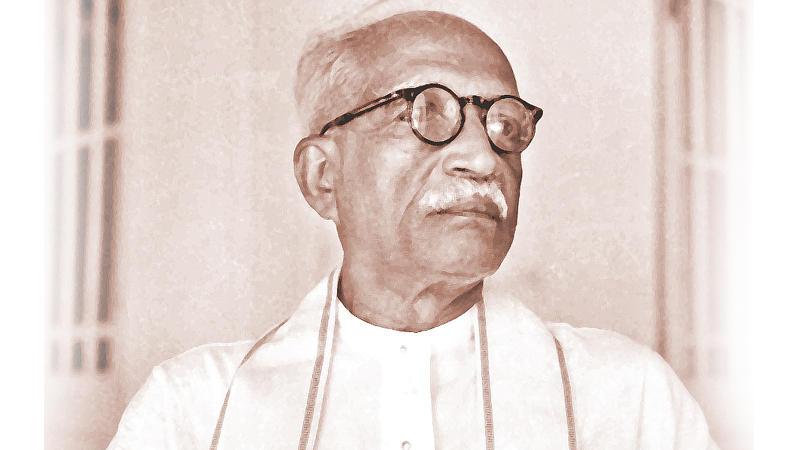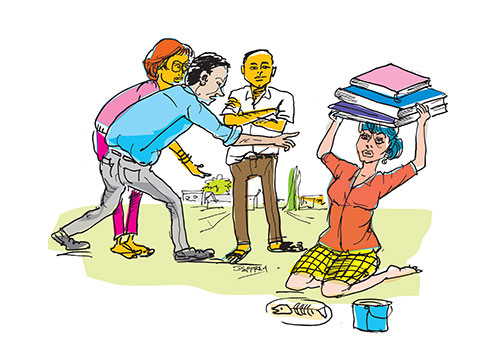By Harshana Rambukwella
In Gunadasa Amarasekara’s novel Inimage Ihalata (Up the Ladder), Piyadasa – a young undergraduate from a rural background – has an epiphany while watching the daily deva puja at Katharagama. Initially attracted to the pulsating rhythm of the dancers he feels a strong erotic impulse. But within moments he experiences a sense of guilt and turns away from the scene and proceeds to the kiri wehera – the Buddhist Stupa which is part of the Katharagama complex, where he tries to sublimate the desire he felt. Reflecting on this incident Piyadasa wonders why his uncle Bala Mahattaya, who was with him, does not share the same emotions. Piyadasa’s somewhat trite conclusion is that it was his education and exposure to texts such as Lady Chatterley’s Lover that caused this reaction while Bala Mahattaya – an obvious organic rural foil to Piyadasa – is immune due to his lack of education. Most of Amarasekara’s later work – after he wrote novels like Karumakkarayo and Deppa Noladdo which explored sexually daring themes – have these moralistic undertones. There is also a certain crudeness to how Amarasekara stages a conflict between what he sees as corruptive ‘western’ values and a romanticised notion of pastoral Sinhala identity.
Why did I begin with this anecdote from Gunadasa Amarasekara’s fiction? I believe this anecdote speaks to a deep-seated problem in Sri Lankan society – particularly within what we might call the ‘middle classes’ – and how education has also been a site in which this problem is reproduced. However, the problem I refer to is not a Victorian attitude towards sexuality per se but a more general problem with conformity. When Piyadasa thinks he has been ‘corrupted’ by western values he is in effect enacting an act of cultural conformity that Amarasekara replicated in real life – where he essentially recanted his earlier work following public criticism by Martin Wickramasinghe. Wickramasinghe accused Amarasekara of distorting rural Sinhala culture and Amarasekara subsequently began to craft his fiction to fit a perceived conformist cultural script.
I was reminded of Amarasekara’s fiction when news broke of an incident where a student couple embracing in front of the Senate building at the University of Peradeniya were physically and verbally censured. In a country where expressions of public affection are frowned upon, these ideas seem to be even more entrenched within the university – a space one would like to imagine as more ‘progressive’. This intolerance has even extended to artistic performances when an on-stage kiss in a drama production in 2016 at the famous wala in Peradeniya resulted in the performance having to be abandoned. This culture of intolerance also takes a much more insidious form through ragging where physical and psychological suffering is inflicted upon students. Ragging has essentially become a method through which a culture of cultural and political conformity is enforced. However, we are also confronted with a seeming paradox. In the same university there are regular student protests against institutional overreach, the political culture of the country and even national economic issues. Most of these protests are often mobilised by student unions, which also played a critical role during last year’s aragalaya. But perhaps there is no paradox because it is the very same culture of conformity that is enforced within the university that makes the student body such a potent collective political force. However, this comes at significant social cost, and this is why such cultures of conformity need to be resisted and contested.
At one level we have a culture within the university where student’s bodies and minds are forcefully disciplined. Especially when you first enter university an enforced dress code, codes of docile behaviour and modes of addressing ‘seniors’ are enacted with force. This is damaging to the personalities of new students. Many students have experienced different culture of conformity – possibly within their homes, in their schools and perhaps in society as a whole. Therefore, when confronted with another regime of conformity at university the students tend to adapt to it with little resistance. So, there are contradictory forces at play. On the one hand the students are forced to adapt to a general culture of conformity but this conformity in turn is used to mobilise them as a collective force to challenge the general political and status quo – the students rarely question the power structures within the university but are ardent critiques of power structures in society at large. Individual liberty and freedom of choice is curtailed, ostensibly in the service of a greater collective ‘good’. In a country with a long and insidious history of nationalist conformity both within the Sinhala and Tamil communities this kind of collective mobilisation – even when it might be seen to serve a greater ‘good’ – is damaging and contributes little to social progress.
Another factor that compounds this collective culture of conformity is the culture of the university as an institution. Rather than foster critical and independent thinking, at multiple levels the institutional practices themselves breed conformity. Within the classroom, it is often the teacher’s views that are dominant and in assessments, students instinctively know, that reproducing the teacher’s ideology is likely to earn them better grades. This in turn generates a culture of intellectual conformity that is layered on top of the conformist cultures students experience in student politics and student life. This is of course not to suggest that all students or even all student groups passively submit to this culture but this appears to be the general habitus of university life. The kind of pedagogical conformity I discussed above – in terms of how teaching and learning happens – can also unfortunately extend to what teachers expect of their students. Many teachers, while they may speak of the importance of critical and independent thinking, rarely provide a space within the classroom that inspires this kind of independence – rather much of their teaching practice indirectly reinforces conformity.
Moving from the teaching and learning aspect of the institution to institutional culture as a whole, it seems to me that the university administration also prefers conformity. For instance, some university administrators infantilise students through the use of terms such as putha or duwa (son or daughter) which at first sight are terms of affection and endearment but in reality are highly condescending forms of address to youth who are legal adults. A further manifestation is how students stand when a teacher enters a classroom – never openly articulated or demanded by teachers but an unwritten code that reinforces teacher-student hierarchy. The kissing incident I referenced above, ironically was a rare moment when institutional discourses of conformity converged with those of the majority student body.
However, the same institution which attempts to infantilize students can go from being benign to violent rapidly and call upon state repression to discipline students. Some universities further instill such behaviors of conformity through institutional rituals – such as the playing of the national anthem during working hours and the expectation that staff and students pay ‘respect’ to the anthem regardless of what they are doing – a somewhat new form of nationalist conformity that emerged in recent years in many public institutions in Sri Lanka.
It seems to me, therefore, that conformity is reinforced from multiple sources and directions. The school system in Sri Lanka is highly discipline-oriented and attempts to discipline what it sees as unruly bodies and minds of students from the moment they begin schooling. Many students experience such practices in their home environment (especially in middle class homes) and therefore in turn find school to be an extension of their lived experience, rather than a place that can emancipate them. This tragedy is compounded when they enter university which is supposed to be a liberal and progressive space. There is, therefore, an urgent need to critically reflect on how we can address the problem of how to challenge such cultures conformity. There is no easy or short-term fix for a problem of this nature. Perhaps the first step is to acknowledge that such a problem does exist. Thereafter, look at ways in which this insidious reproduction of conformity can be at least challenged at the university level. But to do so, at least four different segments of university life need to be rethought and reorganized: student beliefs and practices; institutional behaviors and practices; and last but not least the beliefs, habitus and practices of faculty in relation to teaching and the university administration and staff in how they relate to students. This is a somewhat utopian expectation but one has to hope that the conversation will begin somewhere.



